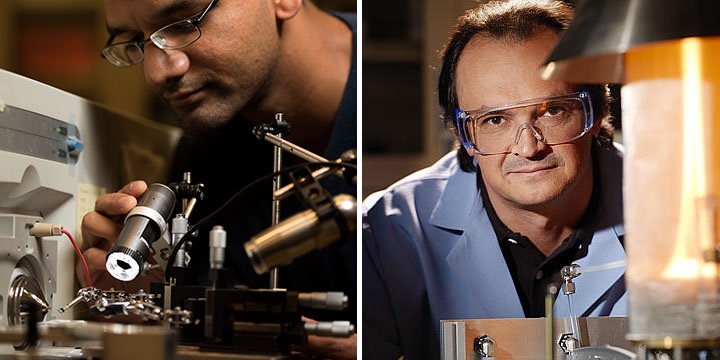Atmospheric Aerosols and Their Chemical Complexities
Published: 19 April 2021
With ARM and ASR support, a cross-country pair of collaborators use imaging strategies to peel open some enduring aerosol mysteries

Swarup China and Alexander Laskin are among a group of scientists who study the complex, dynamic, and highly reactive chemistry of atmospheric aerosols.
These tiny liquid and solid particles, suspended in the air from hours to weeks, influence cloud formation, precipitation, and the Earth’s energy budget.
China is at the Environmental Molecular Sciences Laboratory (EMSL) in southeastern Washington state; Laskin, a former EMSL scientist, is at Purdue University in Indiana. Despite being nearly a continent apart, the two have maintained an aerosol-centric research collaboration for more than five years.
Very often, their research proceeds with the help of EMSL, a U.S. Department of Energy (DOE) scientific user facility, and two other DOE entities. These entities are Atmospheric System Research (ASR), a source of competitive funding, and the Atmospheric Radiation Measurement (ARM) user facility, which maintains data-collecting observatories in climate-critical regions of the world.
China and Laskin face a core challenge: The multiphase chemistry of atmospheric aerosols is very complex. Such particles―affected by sunlight, water content, and other variables―are in a state of constant chemical mixing. That changes aerosol sizes, shapes, composition, and properties in an evolutionary process called atmospheric aging.
Beyond that chemical complexity, researchers also must consider the sheer diversity of aerosol sources. Such particles can originate as soot and organic particles from power plants, combustion engines, and wildfires. They can also get their start as mineral-rich dust and sea spray, or as fragments of soil, plant matter, fungi, and bacteria.
The variety of these sources reflects the immense array of land, ocean, and human activity and interactions that shed particles into the air. This shedding can happen at the scale of continent-sized dust storms or during something as simple as turning over soil in your backyard garden.
From Field and Forest

Together, China and Laskin use chemical imaging techniques that peel back aerosol samples to the level of atoms and ions. Along the way, they have helped investigate how raindrops splash aerosols into the air at ARM’s Southern Great Plains atmospheric observatory in rural Oklahoma. In another example, with ARM data and samples from the same site, the two researchers contributed to papers on the optical properties and composition of high-viscosity organic particles.
China’s work at EMSL often turns to studying aerosols that are directly swept into the air from forests and farm fields.
He led one paper, with support from ASR, that established the importance of ruptured fungal spores as a source of submicron aerosol particles above and below an Amazonian forest canopy. (Laskin was a co-author.) In part, the research was a feat of EMSL-enabled chemical imaging. The chemical composition of such particles, each less than a millionth of a meter long, is hard to distinguish from other particle types.
Laskin tapped ASR funding in a follow-up study that used samples from air above the same Amazonian terrain. China, Laskin, and their co-authors revealed a surprise: Most cloud-forming sodium salt particles in the air above rainforests come from fungal spores, not from distant oceans.
To learn more about their collaborations, including chemical imaging techniques, read this EMSL feature.
Keep up with the Atmospheric Observer
Updates on ARM news, events, and opportunities delivered to your inbox
ARM User Profile
ARM welcomes users from all institutions and nations. A free ARM user account is needed to access ARM data.


















